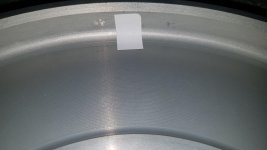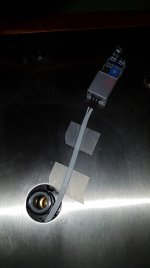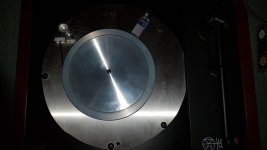Question for alternative sensor mounting
LP12 owners or anyone with a similar platter with lots of space underneath. I would like to canvass your opinion. As you have seen by previous pictures the optical sensor is mounted in a shared OLED case (with optional switch) and you need to route a thin 10mm wide flexible circuit strip back to the PCB for the connections.
At the weekend a friend asked me to install a unit for him but was not so keen on having the black OLED box visible. I mounted the optical sensor inside the platter. This has advantages in that the white optical marker is now no longer visible on the outside of the platter. I routed the cable through the central bearing hole. (Ribbon cable in beta boards, so had to tape down, but FPC flexible circuit in production units). But what to do with the OLED? He was looking to mount somewhere well away from the turntable so he cannot see it in normal operation.
Looking for opinion if this is an option everyone would like to see and suggestions for OLED.
NB: Incidentally his LP12 TT with Valhalla/Motor was running at 33.4 rpm. Valhalla was OK but it was the motor. After fitting the speed controller and turning on PID control we got 33.33x with the last x digit fluctuating a bit.
LP12 owners or anyone with a similar platter with lots of space underneath. I would like to canvass your opinion. As you have seen by previous pictures the optical sensor is mounted in a shared OLED case (with optional switch) and you need to route a thin 10mm wide flexible circuit strip back to the PCB for the connections.
At the weekend a friend asked me to install a unit for him but was not so keen on having the black OLED box visible. I mounted the optical sensor inside the platter. This has advantages in that the white optical marker is now no longer visible on the outside of the platter. I routed the cable through the central bearing hole. (Ribbon cable in beta boards, so had to tape down, but FPC flexible circuit in production units). But what to do with the OLED? He was looking to mount somewhere well away from the turntable so he cannot see it in normal operation.
Looking for opinion if this is an option everyone would like to see and suggestions for OLED.
NB: Incidentally his LP12 TT with Valhalla/Motor was running at 33.4 rpm. Valhalla was OK but it was the motor. After fitting the speed controller and turning on PID control we got 33.33x with the last x digit fluctuating a bit.
Attachments
LP12 owners or anyone with a similar platter with lots of space underneath. I would like to canvass your opinion...
That's a cool idea and I'd like to implement it. As for the display, since that's a (hopefully) set it up and forget it sort of thing, I wouldn't mind putting it in a box and tugging it somewhere behind the plint.
I can't help but wonder what Ivor Tiefenbrun, who once forbid any digital watches in his listening room, would think of all these Arduino and SMPS and things, just inches away from the cartridge...
Edit: actually, I'm also thinking of putting them in a separate box.
LP12 owners or anyone with a similar platter with lots of space underneath. I would like to canvass your opinion. As you have seen by previous pictures the optical sensor is mounted in a shared OLED case (with optional switch) and you need to route a thin 10mm wide flexible circuit strip back to the PCB for the connections.
At the weekend a friend asked me to install a unit for him but was not so keen on having the black OLED box visible. I mounted the optical sensor inside the platter. This has advantages in that the white optical marker is now no longer visible on the outside of the platter. I routed the cable through the central bearing hole. (Ribbon cable in beta boards, so had to tape down, but FPC flexible circuit in production units). But what to do with the OLED? He was looking to mount somewhere well away from the turntable so he cannot see it in normal operation.
Looking for opinion if this is an option everyone would like to see and suggestions for OLED.
NB: Incidentally his LP12 TT with Valhalla/Motor was running at 33.4 rpm. Valhalla was OK but it was the motor. After fitting the speed controller and turning on PID control we got 33.33x with the last x digit fluctuating a bit.
I have not seen the circuit diagram, but can the controller work without the display? If so some of us would like to run the Turntable without the display. IMO the display is not really necessary for all users. One could set the motor parameters via the interface, verify proper operation then run the LP 12 sans display.
Mounting the sensor inside the platter is a Good Idea. Less clutter.
Thanks for your efforts. Much appreciated.
OK couple of answers and comments to above:
>>Yes I wonder, but its no worse than a Valhalla. The SMPS and the Arduino operate at 66KHz and 16MHz respectively, well away from the audible range. Magnetics are the killer around a cartridge, hence the choice not to have a transformer. I also do run my board in a separate enclosure. I will post some proper pictures of the external enclosures to help users get an idea of how you can do this.
>>Yes you can run the board without the OLED display - entirely optional. You can monitor correct operation via serial console initially as it shows speed output/. Then disconnect. No display needed at all.
I can't help but wonder what Ivor Tiefenbrun, who once forbid any digital watches in his listening room, would think of all these Arduino and SMPS and things, just inches away from the cartridge...
Edit: actually, I'm also thinking of putting them in a separate box.
>>Yes I wonder, but its no worse than a Valhalla. The SMPS and the Arduino operate at 66KHz and 16MHz respectively, well away from the audible range. Magnetics are the killer around a cartridge, hence the choice not to have a transformer. I also do run my board in a separate enclosure. I will post some proper pictures of the external enclosures to help users get an idea of how you can do this.
I have not seen the circuit diagram, but can the controller work without the display? If so some of us would like to run the Turntable without the display. IMO the display is not really necessary for all users. One could set the motor parameters via the interface, verify proper operation then run the LP 12 sans display.
Mounting the sensor inside the platter is a Good Idea. Less clutter.
Thanks for your efforts. Much appreciated.
>>Yes you can run the board without the OLED display - entirely optional. You can monitor correct operation via serial console initially as it shows speed output/. Then disconnect. No display needed at all.
Hi nothing has registered on the form. Can you try again please.
I have done the form. Hit 'send' and I got no feedback, so I hope it worked! May have hit send twice in the process.
Cheers
... I will post some proper pictures of the external enclosures to help users get an idea of how you can do this.
...
Yes, that'd be helpful. Please include the dimensions so I can start looking for a box. Thanks.
Hi nothing has registered on the form. Can you try again please.
Used a different browser - hopefully a better result!
Google Doc? Have I missed something? I just added my name to the list here.
Hi Stefan.
Here is the Link to the Google Doc form.Motor Controller GB-1
Regards
Ray
Last edited:
LP12 owners or anyone with a similar platter with lots of space underneath. I would like to canvass your opinion. As you have seen by previous pictures the optical sensor is mounted in a shared OLED case (with optional switch) and you need to route a thin 10mm wide flexible circuit strip back to the PCB for the connections.
At the weekend a friend asked me to install a unit for him but was not so keen on having the black OLED box visible. I mounted the optical sensor inside the platter. This has advantages in that the white optical marker is now no longer visible on the outside of the platter. I routed the cable through the central bearing hole. (Ribbon cable in beta boards, so had to tape down, but FPC flexible circuit in production units). But what to do with the OLED? He was looking to mount somewhere well away from the turntable so he cannot see it in normal operation.
Looking for opinion if this is an option everyone would like to see and suggestions for OLED.
NB: Incidentally his LP12 TT with Valhalla/Motor was running at 33.4 rpm. Valhalla was OK but it was the motor. After fitting the speed controller and turning on PID control we got 33.33x with the last x digit fluctuating a bit.
Clearance in the bearing hole looks a bit tight. Will production cables be thinner?
Thanks Ray, done. Let me know where to pay. Are you going to send us all PayPal requests?
Hi Stefan
I have sent you a P.M. Think we have our wires crossed somewhere. Steve 'scobham' put the link up on post 46.
I was just pointing the link out to you.
Regards
Ray
Last edited:
1) Bare PCB and Pre Programmed Arduino Nano 18.00 GBP
2) Full kit of parts 58.00 GB
1 for ZUM911
1 for TKO956
2 for chromenuts
1 for geoturbo
1 for IDM
1 for SPWONG
1 for nlgbo1
1 for oyvind
3) Fully assembled and tested board 98.00 GBP
1 for Orangeart
1 for Raymond
1 for DieterK
1 for koldby
4 for al2002
1 for Sergelisses
1 for JensenHealey
1 for lancer
2 for hirscwi (shipping to US)
1 for Zung (shipping to Switzerland)
a) Linn Valhalla switch connector option 1.00 GBP
1 for Orangeart
1 for ZUM911
1 for Raymond
4 for al2002
1 for Sergelisses
1 for IDM
1 for Zung
1 for SPWONG
b) Momentary action switch/LED to fit OLED enclosure 4.50GBP
1 for DieterK
1 for ZUM911
1 for Sergelisses
1 for Raymond
1 for JensenHealey
2 for al2002
1 for TKO956
1 for geoturbo
2 for hirscwi
1 for IDM
1 for Zung
1 for nlgbo1
1 for oyvind
Google form also submitted.
2) Full kit of parts 58.00 GB
1 for ZUM911
1 for TKO956
2 for chromenuts
1 for geoturbo
1 for IDM
1 for SPWONG
1 for nlgbo1
1 for oyvind
3) Fully assembled and tested board 98.00 GBP
1 for Orangeart
1 for Raymond
1 for DieterK
1 for koldby
4 for al2002
1 for Sergelisses
1 for JensenHealey
1 for lancer
2 for hirscwi (shipping to US)
1 for Zung (shipping to Switzerland)
a) Linn Valhalla switch connector option 1.00 GBP
1 for Orangeart
1 for ZUM911
1 for Raymond
4 for al2002
1 for Sergelisses
1 for IDM
1 for Zung
1 for SPWONG
b) Momentary action switch/LED to fit OLED enclosure 4.50GBP
1 for DieterK
1 for ZUM911
1 for Sergelisses
1 for Raymond
1 for JensenHealey
2 for al2002
1 for TKO956
1 for geoturbo
2 for hirscwi
1 for IDM
1 for Zung
1 for nlgbo1
1 for oyvind
Google form also submitted.
Regarding the Google form I will contact anyone on the list that has not submitted. I will use the details on the form to send out PayPal invoices later this week. Currently away with work.
Regarding the cables looking a bit tight, through the bearing hole; as I mentioned production units will have an FPC cable which are very thin. My beta boards do not have the fine pitch connectors on them so had to use thicker ribbon cable.
Regarding the cables looking a bit tight, through the bearing hole; as I mentioned production units will have an FPC cable which are very thin. My beta boards do not have the fine pitch connectors on them so had to use thicker ribbon cable.
- Home
- Group Buys
- Turntable Tachometer and motor speed controller


